Lab 5
Faraday's law
Changing magnetic fields are a source of electric fields. Faraday's law states that the emf induced in a loop is equal to the rate of CHANGE of the magnetic flux through the area enclosed by the loop. The equation below expresses Faraday's law in mathematical form.
ΔΦB/∆t (through a fixed area) = -emf
In this studio session you will use a simulation to explore consequences of Faraday's law, and another simulation to explore the inductance of circuit elements.
Open a Microsoft Word document to keep a log of your experimental procedures, results and discussions. This log will become your lab report. Address the points highlighted in blue. Answer all questions.
Activity 1
Please watch this Lenz's law demonstrations
Youtube video
https://www.youtube.com/watch?v=k2RzSs4_Ur0
-
Briefly describe the three experiment performed in this video clip and explain how the demonstrate Lenz's law.
Exploration 1
a) Use an on-line simulation from the University of Colorado PhET group to explore Faraday's law.
Link to the simulation:
https://phet.colorado.edu/en/simulations/faradays-law
What happens when a magnet moves through a coil in which a current can flow?
Move the magnet at a
relatively constant frequency back and forth through the coil. The voltage displayed is proportional to the current
flowing in the coil. Watch the reading of the voltmeter. What happens
- as you move the magnet through the coils with different number of loops,
- as you change the frequency and therefore the speed of the magnet for a given number of loops,
- as you change the polarity of the magnet?
Record your observations for each type of change.
(b) In a transformer, a current in one coil creates a magnetic field. When the flux of this magnetic field through the second coil changes, an induced current flows in the second coil.
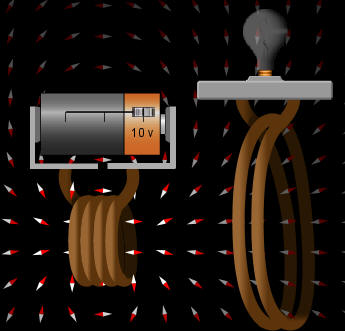
- Refer to the image on the right. With a direct current (DC) flowing in the primary coil, predict what will
happen as you move the primary coil in and out of the secondary coil.
You can find out by opening the legacy app, https://phet.colorado.edu/en/simulations/legacy/faraday.
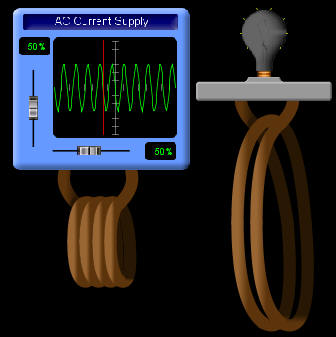
- Refer to the image on the right. With an alternating current (AC) flowing in the primary coil do you have to move the primary to light up the bulb? Why or why not?
In a generator, an external force moves a magnet. The external force does work and this work is converted into electrical energy.
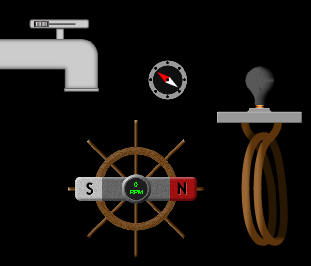
- Refer to the image on the right. Describe how this simple model for the generators in a hydroelectric plant works.
- Imagine you were actually turning the magnet by hand to generate a current. Neglecting friction, would you have to do work to keep the wheel turning?
Exploration 2
Use an on-line simulation from the University of Colorado PhET group to explore the inductance
of circuit elements.
Link to the simulation:
http://phet.colorado.edu/sims/html/circuit-construction-kit-ac/latest/circuit-construction-kit-ac_en.html
Click the Lab tab.
- Components are dragged from the toolbox to make circuits which can be monitored using meters and charts.
- To explore the properties of a component, tap it. You can then change many properties and also remove the component.
Construct the circuit shown below.
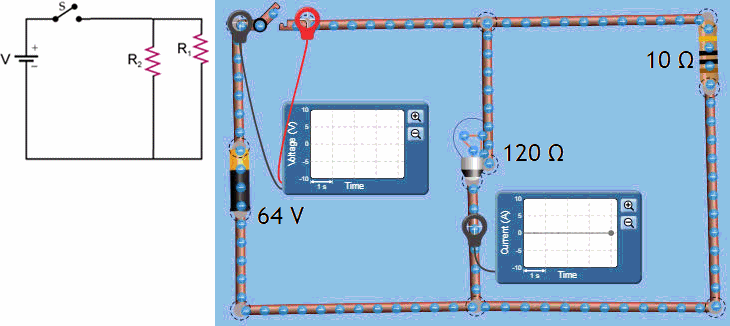
Use a 64 V battery in series with a switch, connected to a 10 Ω resistor R1 and a light bulb
with resistance R2 = 120 Ω in parallel. Use a current chart to
monitor the current through the bulb and a voltage chart to monitor the voltage
across the switch.
Make
predictions before you play the animation:
- Before you close the switch, predict the voltage across the switch and the current through the bulb. Record your prediction.
- After you close the switch, predict the voltage across the switch and the current through the bulb. Record your prediction.
Play the animation.
- Does the animation support your predictions? Adjust the scales on the chart recorders appropriately.
- Flip the switch a few times. How long does it take for the current through the bulb and the voltage across the switch to change after you flip the switch?
Stop the animation.
Construct another circuit as shown below.
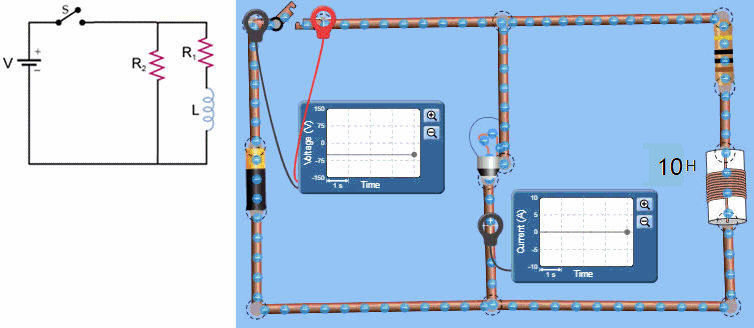
 Play the animation.
Play the animation.
- Describe what happens to the voltage across the switch and the current
through the bulb when you close the switch.
What is the maximum current through the bulb and the maximum voltage across the switch? - Describe what happens to the voltage across the switch and the current
through the bulb when you open the switch.
What is the maximum current through the bulb and the maximum voltage across the switch? - Because the coil of a motor has a self inductance L, an emf proportional to the rate of change of the current in the coil is induced. When you flip the switch, the rate of change is very high, and the induced emf can be several times the power supply voltage. Do you observe such an induced emf?
A spark across the switch can be prevented, by connecting a diode in parallel with the inductor. A diode is an electronic component that lets current flow through it in only one direction. It has near zero resistance when "forward biased", and very high resistance when "reverse biased". When the switch is closed, the diode is reverse biased and affects the circuit minimally. When the switch is opened, the diode become forward biased and current flows through the near-zero resistance diode instead of arcing across the switch. Unfortunately the simulation does not let us put a diode into the circuit.

Convert your log into a lab report. See the grading scheme for all lab reports.
Name:
E-mail address:
Laboratory 5 Report
- In one or two sentences, state the goal of this lab.
- Make sure you completed the entire lab and answered all parts. Make sure you show your work and inserted and properly labeled relevant tables and plots.
- Add a reflection at the end of your report in a short essay format.
Save your Word document (your name_lab5.docx), go to Canvas, Assignments, Lab 5, and submit your document.